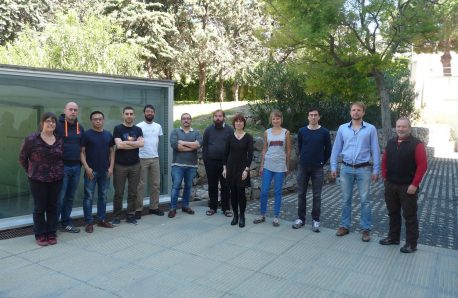López
Research group

Abstract
The aim of the group is to employ atomistic simulations to understand the mechanisms that govern chemical processes in heterogeneous catalysis and other materials that might be appealing due to their ability to extract, store or provide energy. Both the analysis of reaction networks, activity and selectivity issues and the final tests on the stability of the potential materials are fundamental to establish a solid background to determine the potentialities of catalyst candidates for a given chemical transformation. As for the new energy materials their performance and stability are two of the main goals in our research.
Our collaboration with several experimental groups is of fundamental importance to define and compare models that can later be applied to suggest experiments and new materials to be explored. To this end, the use of massive computational resources, as those provided by the RES-BSC is required. We are thankful to them for these resources that help in placing us as players at the European level.
Topics addressed
- Atomistic simulations of chemical processes in heterogeneous catalysis.
- Understanding new energy materials’ performance and stability.
Articles
“Managing the Computational Chemistry Big Data problem: the ioChem-BD platform”
Chem. Inf. Model. (2015) 55, 95–103
M. Álvarez Moreno, C. De Graaf, N. López, F. Maseras, J. M. Poblet, C. Bo
“Density Functional Theory Comparison of Methanol Decomposition and Reverse Reactions on Metal Surfaces”
ACS Catal. (2015) 5, 1027−1036
R. García-Muelas , Q. Li , N. López
“Nanoparticle shapes by using Wulff constructions and first-principles calculations”
Beilstein J. Nanotechnol. (2015) 6, 361–368.
G.D. Barmparis, Z. Łoziana, N. López, I. N. Remediakis
“A single atom change “switches-on” solar-to-energy conversion efficiency on Zn-porphyrin based dye sensitized solar cell to 10.5%”
Energy Environ. Sci., (2015) 8, 1368–1375
E.J. Palomares, L. Cabau, V. Kumar Challuri, A. Moncho, J. N. Clifford, N. López
“When the solvent locks the cage: theoretical insight into the transmetalation of MOF-5 lattices and its kinetic limitations”
Chem. Mater. (2015) 27, 3422–3429
L.Bellarosa, C. Kavanaugh Brozek, M. García-Melchor, M. Dinca, N. López
“Free Energy Assessment of Water Structures and Their Dissociation on Ru(0001)”
Phys. Chem. C, (2015) 119, 5478–5483
G.Revilla-López, P. Błoński , N. López
“Structure, Activity, and Deactivation Mechanisms in Double Metal Cyanide Catalysts for the Production of Polyols”
ChemCatChem (2015) 7, 928–935
N.Almora-Barrios, S. Pogodin, L. Bellarosa, M. García-Melchor, G. Revilla-López, M. García-Ratés, A. B. Vázquez-García, P. Hernández-Ariznavarreta, N. López
“Unraveling the structure sensitivity in methanol conversion on CeO2: A DFT+U study”
Catal. (2015) 327, 58–64
M. Capdevila-Cortada, M. García-Melchor, N. López
“The Active Molybdenum Oxide Phase in the Methanol Oxidation to Formaldehyde (Formox Process): A DFT Study”
ChemSusChem (2015) 8, 13, 2231–2239
M. Rellán-Piñeiro, N. López
“Structure and reactivity of supported hybrid platinum nanoparticles for the flow hydrogenation of functionalized nitroaromatics”
ACS Catal. (2015) 5, 3767–3778
G. Vilé, N. Almora-Barrios, N. López, J. Pérez-Ramírez
“A stable single-site palladium catalyst for hydrogenations”
Angew. Chem. Int. Ed. (2015) 54, 11265 –11269
G. Vilé, D. Albani, M. Nachtegaal, Z. Chen, D. Dontsova, M. Antonietti, N. López, J. Pérez-Ramírez
“Dynamic DMF Binding in MOF-5 Enables the Formation of Metastable Cobalt-Substituted MOF-5 Analogues”
ACS Cent. Sci. (2015) 252–260
C. K. Brozek , V. K. Michaelis , T-C. Ong, L. Bellarosa, N. López, R. G. Griffin, M. Dincă
“Descriptor Analysis in Methanol Conversion on Doped CeO2(111): Guidelines for Selectivity Tuning”
ACS Catalysis (2015) 5, 6473-6480
M. Capdevila-Cortada, N. López